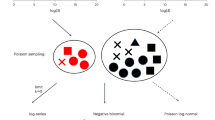Abstract
Attempts to assess the magnitude of global biodiversity have focused on estimating species richness. However, this is but one component of biodiversity, and others, such as numbers of individuals or biomass, are at least as poorly known and just as important to quantify. Here, we use a variety of methods to estimate the global number of individuals for a single taxon, birds. The different methods yield surprisingly consistent estimates of a global bird population of between 200 billion and 400 billion individuals (1 billion=109). We discuss some of the implications of this figure.
Similar content being viewed by others
References
Banks, R.C. (1979) Human related mortality in birds in the United States. U.S. Fish and Wildlife Service Special Scientific Report. Wildlife No. 215.
Blackburn, T.M. and Gaston, K.J. (1994) The distribution of body sizes of the world's bird species. Oikos 70, 127–30.
Blackburn, T.M. and Gaston, K.J. (1996) A sideways look at patterns in species richness, or why are there so few species outside the tropics? Biodiv. Lett. 3, 44–53.
Blackburn, T.M., Gates, S., Lawton, J.H. and Greenwood, J.J.D. (1994) Relations between body size, abundance and taxonomy of birds wintering in Britain and Ireland. Phil. Trans. R. Soc. Lond. B 343, 135–44.
Brown, L.H., Urban, E.K. and Newman, K. (1982) The Birds of Africa, Vol. 1. London: Academic Press.
Carrascal, L.M. and Tellería, J.L (1991) Bird size and density: a regional approach. Am Nat. 138, 777–84.
Cotgreave, P. (1995) Population density, body mass and niche overlap in Australian birds. Funct. Ecol. 9, 285–9.
Cotgreave, P. and Harvey, P.H. (1994) Phylogeny and the relationship between body size and abundance in bird communities. Funct. Ecol. 8, 219–28.
Dunning, J.B. (1992) CRC handbook of Avian Body Masses. Boca Raton: CRC Press.
Elton, C. (1927) Animal Ecology. London: Sidgwick & Jackson.
Erwin, T.L. (1982) Tropical forests: their richness in Coleoptera and other arthropod species. Coleopt. Bull. 36, 74–5.
Gaston, K.J. (1991) The magnitude of global insect species richness. Conserv. Biol. 5, 283–96.
Gaston, K.J. (1992) Regional numbers of insect and plant species. Funct. Ecol. 6, 243–7.
Gaston, K.J. and Hudson, E. (1994) Regional patterns of diversity and estimates of global insect species richness. Biodiv. Conserv. 3, 493–500
Gaston, K.J. and May, R.M. (1992) Taxonomy of taxonomists. Nature 356, 281–2.
Gibbons, D.W., Reid, J.B. and Chapman, R.A. (1993) The New Atlas of Breeding Birds in Britain and Ireland: 1988–1991. London: T. & A.D. Poyser.
Groombridge, B. (ed.) (1992) Global Biodiversity: Status of the Earth's Living Resources. London: Chapman & Hall.
Heywood, V.H. (ed.) (1995) Global Biodiversity Assessment. Cambridge: Cambridge University Press.
Hodkinson, I.D. and Casson, D. (1991) A lesser predilection for bugs: Hemiptera (Insecta) diversity in tropical rain forests. Biol. J. Linn. Soc. 43, 101–9.
Juanes, F. (1986) Population density and body size in birds. Am. Nat. 128, 921–9.
Klem, Jr. D. (1990) Collisions between birds and windows: mortality and prevention. J. Field. Ornithol. 61, 120–8.
Kobayashi, S. and Kimura, K. (1994) The number of species occurring in a sample of a biotic community and its connections with species-abundance relationship and spatial distribution. Ecol. Res. 9, 281–94.
Magnin, G. (1991) Hunting and persecution of migratory birds in the Mediterranean region. In Conserving Migratory Birds (T. Salathé, ed.), pp. 63–75. Cambridge: International Council for Bird Preservation.
Marchant, J.H., Hudson, R., Carter, S.P. and Whittington, P. (1990) Population Trends in British Breeding Birds. Tring, Hertfordshire: British Trust for Ornithology.
May, R.M. (1990) How many species? Phil. Trans. R. Soc. Lond. B 330, 293–304.
Merikallio, E. (1958) Finnish birds, their distribution and numbers. Fauna Fennica 5, 1–181.
Nee, S., Read, A.F., Greenwood, J.J.D. and Harvey, P.H. (1991) The relationship between abundance and body size in British birds. Nature 351, 312–13.
Osborne, P.E. and Tigar, B.J. (1992) Priorities for bird conservation in Lesotho, southern Africa. Biol. Conserv. 61, 159–69.
Preston, F.W. (1948) The commonness, and rarity, of species. Ecology 29, 254–83.
Remsen Jr., J.V. (1995) The importance of continued collecting of bird specimens to ornithology and bird conservation. Bird Conserv. Int. 5, 145–80.
Rosenzweig, M.L. (1995) Species Diversity in Space and Time. Cambridge: Cambridge University Press.
Sibley, C.G. and Monroe Jr., B.L. (1990) Distribution and Taxonomy of Birds of the World. New Haven: Yale University Press.
Tellería, J.L. and Carrascal, L.M. (1994) Weight-density relationships between and within bird communities: implications of niche space and vegetation structure. Am. Nat. 143, 1083–92.
Terborgh, J., Robinson, S.K., Parker III, T.A., Munn, C.A. and Pierpont, N. (1990) Structure and organization of an Amazonian forest bird community. Ecol. Monogr. 60, 213–38.
Thomsen, J.B., Edwards, S.R. and Mulliken, T.A. (1992) Perceptions, Conservation and Management of Wild Birds in Trade. Cambridge: TRAFFIC International.
Ulfstrand, S. and Hogstedt, G. (1976) Hur manga faglar hackar i Sverige. Anser 15, 1–32.
Walsberg, G.E. (1994) The use of wild birds in research. Condor 96, 1119–20.
Williams, C.B. (1960) The range and pattern of insect abundance. Am. Nat. 94, 137–51.
Wilson, E.O. (1985) The biological diversity crisis. BioScience 35, 700–6.
Winkler, K., Fall, B.A., Klicka, J.T., Parmelee, D.F. and Tordoff, H.B. (1991) The importance of avian collections and the need for continued collecting. Loon 63, 238–46.
Wood, G.L. (1982) The Guinness Book of Animal Facts and Feats. Enfield, Middlesex: Guinness Superlatives.
Wright, D.H., Currie, D.J. and Maurer, B.A. (1993) Energy supply and patterns of species richness on local and regional scales. In Species Diversity in Ecological Communities (R.E. Ricklefs and D. Schluter, eds) pp. 66–74. Chicago: Chicago University Press.
Author information
Authors and Affiliations
Rights and permissions
About this article
Cite this article
Gaston, K.J., Blackburn, T.M. How many birds are there?. Biodiversity and Conservation 6, 615–625 (1997). https://doi.org/10.1023/A:1018341530497
Issue Date:
DOI: https://doi.org/10.1023/A:1018341530497




